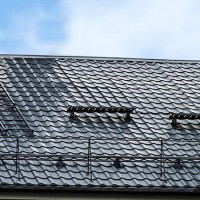How to drill tiles: step-by-step instructions for the work + expert advice
Have you noticed at what point people think about how to drill tiles? Right.At the moment when it has already cracked due to inept actions or an illiterately selected tool. Agree that it is better to devote a few minutes to familiarize yourself with the technology than to waste money, effort and time on purchasing a new product. Which, by the way, is quite difficult to find: very often the shades of batches from the same manufacturer differ noticeably.
There are many instructions and step-by-step algorithms posted online. Masters shoot videos, write articles and comments. Some people focus on the material, while others think the principles of working with the tool are important. One way or another, a huge number of professionals and amateurs are involved in this process.
However, as practice shows, not all methods posted on the Internet are applicable, and not each of them guarantees a positive result. Therefore, we conducted a special study, specifically interviewed experienced tilers and compiled the most competent and detailed report possible. From it you can learn how to make holes in tiles and what you will need for this.
The content of the article:
List of required equipment
First of all, you need to prepare a tape measure and a pencil for marking. If there are two or more holes, then a level will most likely come in handy.
This is especially important when work is carried out to place shelves, cabinets, hangers, heated towel rails, toilets, mirrors
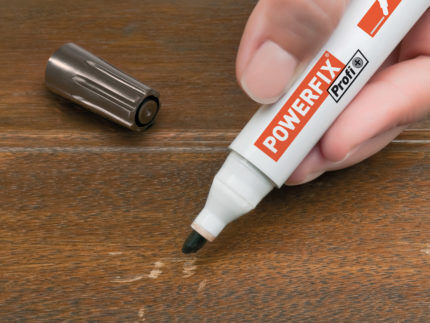
A hammer drill with the impact mechanism disabled, an electric drill or a screwdriver are suitable as the main tool. The declared rotation speed should be from 300 to 1000 rpm.
The next item is drills. You can give preference to products with a diamond coating, as well as feather and core drills coated with tungsten carbide. As practice shows, they do an excellent job with all types of tiles.
When drilling holes of large diameter (up to 9 cm), you need to stock up on “ballerina”. This is the name of a circular drill with adjustable teeth: by fixing the teeth at the desired distance from the center, you can get a hole with the desired radius.
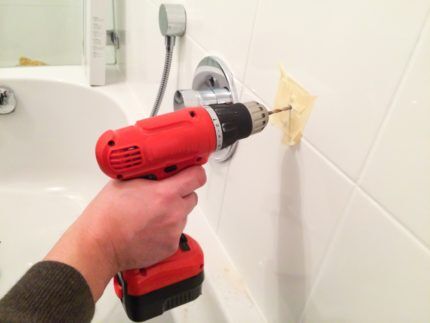
A glass of cold water will also come in handy. It needs to be prepared to cool the drill during operation.
This will be especially true if diamond-coated products have been selected. They demonstrate rapid heating and a significant decrease in cutting properties.
Main stages of work
Drilling can only be done from the front side of the tile. Otherwise, there is a high probability of chipping.
Having made the necessary measurements and applied markings, you can begin to work:
- Place the drill exactly perpendicular to the surface of the tile.
- Slowly, at low speed, beat the enamel at the drilling site.
- Remove any dust that appears and make sure that the actions are correct.
- Start drilling at high speeds, regularly cooling the drill in water.
Having drilled the hole completely, you need to change the drill to one that is suitable for the material behind the tile (wood, brick, concrete).
The diameter of the second drill must completely coincide with the first, and not be larger, as in this case the tile may be damaged.
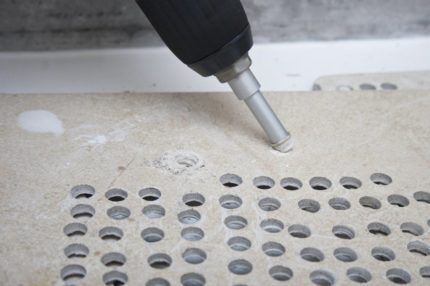
In this case, neither when working with the first drill, nor after replacing it with the second, can you turn on the reverse mode on the tool. This provokes a sharp change in the drilling angle, which is fraught with the appearance of cracks and chips.
Useful tips for different occasions
Knowing the characteristics of various materials and the rules for drilling holes of different sizes, you can give a lot of useful advice.
This is exactly what builders and tilers who have experience in cutting and drilling tiles do. We have collected the most valuable ones in this section.
Drilling large holes with a small drill bit
When drilling holes for pipes, sockets, and lamps, they usually use a “ballerina” or special crowns. However, both cost money. And making a purchase for one time is quite expensive.
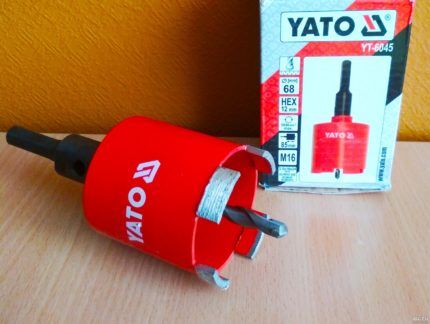
Therefore, many people use a simple drill, solving the problem in this way:
- draw a circle;
- select a simple or feather drill of small diameter;
- make many holes around the entire perimeter of the circle.
Next, all that remains is to carefully release the resulting circle and align the edges of the circle in the tile.
About choosing the location of the hole
If the marked hole is located close to the seam between the tiles, it is worth shifting it to the seam itself or moving it closer to the center.
The fact is that drilling near the seam can cause the tile to split. Especially if it is covered with a layer of enamel.
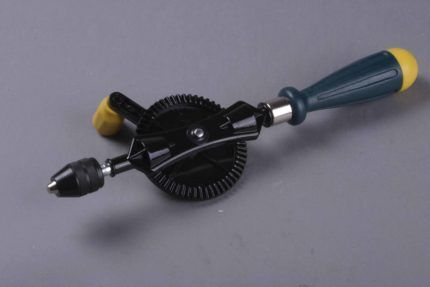
In addition, drilling close to a seam is quite difficult, since the sloping edges of the tiles cause the drill to move.
Experienced craftsmen advise maintaining a distance of 2 cm between the seam and the future hole. This allows you to do the job efficiently and avoid damage to the product.
Drilling for dowels
The preparation and sequence of stages of the work process in this case are no different from conventional drilling.
Difficulties arise only if the drill diameter chosen for the job is too small or the hole is too deep - the dowel “sinks” and ends up far from the surface.
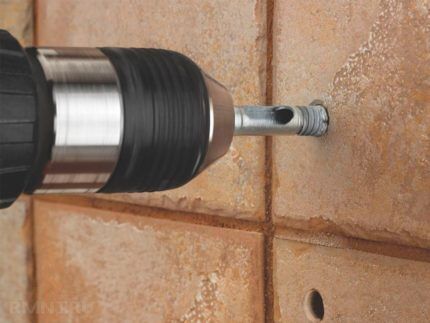
The first issue can be easily corrected by drilling, carefully expanding the edges of the circle to the required parameters.
It is better to foresee the second one in advance: having measured the length of the dowel, put a mark on the drill and go deep exactly to it.
The ability to drill tiles can also be useful if you decide to build inspection hatch in the bathroom.
Common Newbie Mistakes
Surprisingly, many people experience chips and cracks even at the marking stage. This happens when a hammer and a sharp nail are used for these purposes: when trying to leave a mark on the surface of the tile, inexperienced users do not calculate the impact force well. The result is a chip, break or deep crack.
Other common shortcomings include:
- illiterate choice of operating mode of the power tool - too high speeds, use of impact mode;
- incorrect selection of drill;
- poor fixation - the drill slips at the beginning of drilling.
Another common omission is ignoring the search for voids. Experts look for hollow spaces by tapping the tiles.

A dull sound indicates that the tile is tightly adjacent to the surface of the wall or floor, while a ringing sound indicates the presence of voids.
Areas with emptiness should be avoided, since when drilling, cracks often form on them.
Conclusions and useful video on the topic
We also suggest watching a video on the topic, filmed by an experienced master. Pay attention to how carefully he approaches the removal of the top layer and at what stage he uses the hammer drill, only after the tiles have been drilled:
So, we have familiarized ourselves with the list of necessary tools, the main stages of work and advice from the experts.We conclude that the correct selection of a drill, a competent choice of the operating mode of the tool, carefully made markings, surface preparation, and the angle of inclination of the drill during operation are important.
If you have any questions or your experience allows you to give advice, please use the form below. There you can write comments, attach photographs, drawings and diagrams.
